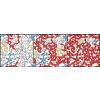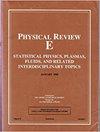Continuum percolation of two-dimensional adaptive dynamics systems
IF 2.4
3区 物理与天体物理
Q1 Mathematics
引用次数: 0
Abstract
The percolation phase transition of a continuum adaptive neuron system with homeostasis is investigated. In order to maintain their average activity at a particular level, each neuron (represented by a disk) varies its connection radius until the sum of overlapping areas with neighboring neurons (representing the overall connection strength in the network) has reached a fixed target area for each neuron. Tuning the two key parameters in the model, i.e., the density defined as the number of neurons (disks) per unit area and the sum of the overlapping area of each disk with its adjacent disks, can drive the system into the critical percolating state. These two parameters are inversely proportional to each other at the critical state, and the critical filling factors are fixed about 0.7157, which is much less than the case of the continuum percolation with uniform disks. It is also confirmed that the critical exponents in this model are the same as the two-dimensional standard lattice percolation. Although the critical state is relatively more sensitive and exhibits long-range spatial correlation, local fluctuations do not propagate in a long-range manner through the system by the adaptive dynamics, which renders the system overall robust against perturbations.

二维自适应动力学系统的连续渗流
本文研究了具有均衡性的连续自适应神经元系统的渗滤相变。为了将平均活动保持在特定水平,每个神经元(用圆盘表示)都会改变其连接半径,直到与邻近神经元的重叠区域总和(代表网络中的整体连接强度)达到每个神经元的固定目标区域。调整模型中的两个关键参数,即密度(定义为单位面积上的神经元(圆盘)数量)和每个圆盘与相邻圆盘的重叠面积之和(定义为每个圆盘与相邻圆盘的重叠面积之和),可以使系统进入临界渗滤状态。在临界状态下,这两个参数成反比,临界填充因子固定为 0.7157,远小于均匀圆盘的连续渗流情况。研究还证实,该模型的临界指数与二维标准晶格渗滤相同。虽然临界状态相对更敏感,并表现出长程空间相关性,但局部波动不会通过自适应动力学在系统中长程传播,这使得系统整体上对扰动具有鲁棒性。
本文章由计算机程序翻译,如有差异,请以英文原文为准。
求助全文
约1分钟内获得全文
求助全文
来源期刊

Physical review. E
物理-物理:流体与等离子体
CiteScore
4.60
自引率
16.70%
发文量
0
审稿时长
3.3 months
期刊介绍:
Physical Review E (PRE), broad and interdisciplinary in scope, focuses on collective phenomena of many-body systems, with statistical physics and nonlinear dynamics as the central themes of the journal. Physical Review E publishes recent developments in biological and soft matter physics including granular materials, colloids, complex fluids, liquid crystals, and polymers. The journal covers fluid dynamics and plasma physics and includes sections on computational and interdisciplinary physics, for example, complex networks.
 求助内容:
求助内容: 应助结果提醒方式:
应助结果提醒方式:


